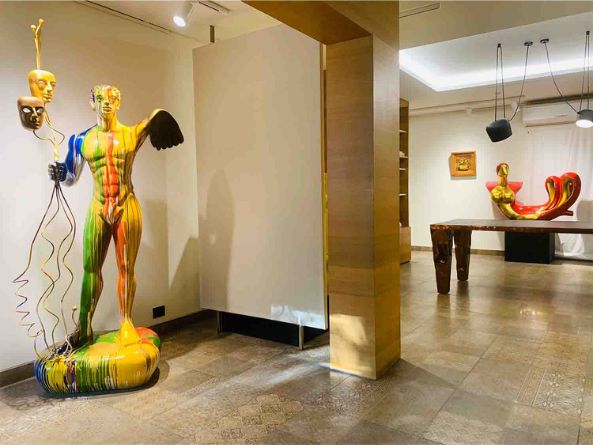From Temples to Galleries: The Modern Journey of Indian Sculpture

From Temples to Galleries: The Contemporary Evolution of Indian Sculpture
The Spiritual Origins of Indian Sculpture
Once upon a time, sculptures in India were not simply art objects - they were expressions of divinity, devotion, and philosophy. They were carved into temple walls, transported in stone, and shaped from clay, all of which communicated the stories of gods and goddesses and the epic poems that form the basis of the Indian tradition.
In ancient India, sculptures served the purpose of visual scriptures. Every curve, gesture, and expression had meaning - meaning that communicated devotion and represented spiritual symbols. Think about the Chola bronzes and the intricate carvings of Khajuraho; these sculptures were not just art pieces, they were meditation in motion, representing a full spectrum of human emotions, experiences, and spirituality.
The Shift: Sacred To Contemporary
As the centuries passed and India transitioned into the modern age, the function of sculpture started to evolve as well. Today, sculptors are fusing tradition with innovation - using metal, stone, and terracotta, and even repurposed materials - to develop new narratives.
With many contemporary artists, their work is consistent with concepts from the traditional books of motifs, creating pieces that are both familiar and unfamiliar. The outcome of this blend is a reawakening of Indian sculpture that will resonate with the spirit and the modern gaze.
Kadari Art Gallery: Where Tradition Meets Modern Vision
Galleries like Kadari Art Gallery serve as connectors of the past with the present. In their presentation of sculptures that combine depth of culture with contemporary visual cues, art lovers can experience the spiritual quality of Indian craft in contemporary design languages.
It is about more than preservation — it is about reinterpreting it — turning sculpture into a dynamic, living art form that naturally moves alongside the beat of modern life.
Outdoor Art: Creative Expression in Open Spaces
Modern sculptors have also brought Indian art into outdoor spaces—from the courtyard, to the garden, to the corporate terrace. When one invests in an outdoor art piece today, they are doing more than fulfilling an aesthetic choice; they are celebrating identity and storytelling.
Whether a stone Buddha, abstracted metal figure, or contemporary installation, an outdoor art piece creates a dialogue between nature and art, bringing soul and craft in reaction to consciousness and space.
Why Collectors Care about Outdoor Sculpture for Sale
For collectors, outdoor sculpture for sale offers more than an object of ownership; it offers the embrace of experience. Each piece offers its own rhythm - a two-person collaboration of craft and creativity whose nature can hold time.
Some of these artworks weather different seasons and develop character and depth. Much like the heritage of Indian art.
Modern Sculpture: The Artistic Dialogue between Form and Spirit
In this new era of Indian sculpture, we are invited to appreciate form, aesthetic elements, and expression more than just religious connotation-the hand of the artist, the interpretation of the viewer, and the connection between matter and meaning.
It is an art still capable of moving people, still able to inspire, still able to change the ambience of places-whether sculpted in stone or cast in bronze.
Walking Through Time and Imagination
As art lovers walk through the halls of the Kadari Art Gallery, they witness how Indian sculpture has evolved from sacred walls of temples to elegant displays of modern times, with the essence of its ancient spirit.
A journey that reminds us that, while time constantly progresses art, it is itself timeless.
Frequently Asked Questions (FAQs) :
1. What is the evolution of Indian sculpture like over time?
Indian sculpture has moved away from being bound to temples and spiritual toward a contemporary expression of creativity, expressed through galleries and modern spaces.
2. Why is outdoor art becoming popular today?
Outdoor art brings together beauty and emotion, transforming open spaces into art spaces that carry culture and individuality.
3. What's the distinction of Indian outdoor sculptures?
Indian outdoor sculptures have a unique blend of deep-rooted tradition and modernity, ensuring that their appeal is timeless and can be incorporated in any setting.
4. Can I simply buy an outdoor sculpture for modern homes?
Absolutely! There are many galleries, like Kadari Art Gallery, that sell outdoor sculpture for sale that look "just right" in gardens, patios, or even inside courtyards.
5. What are common materials for contemporary Indian sculpture?
Artists today use a variety of mixed materials: stone, bronze, metal, terracotta, and even eco-friendly materials, for example, in pots, creating more traditional works but also testing out new directions.









